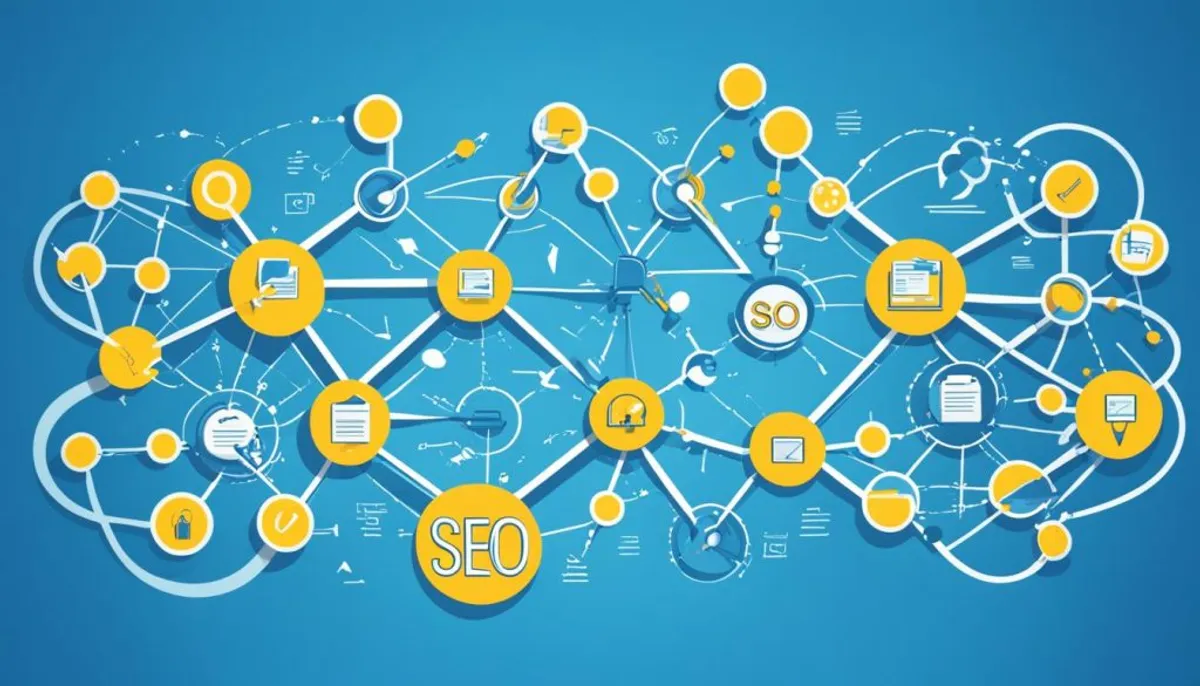Are you confused about whether to focus on search engine optimization (SEO) or search engine marketing (SEM) for your website? Both strategies have their strengths and can drive valuable traffic to your site. Understanding the differences between SEO and SEM can help you make an informed decision that aligns with your goals and resources.
SEO is all about optimizing your website to improve its organic search rankings. By implementing best SEO practices, such as keyword optimization, high-quality content, and user-friendly website structure, you can increase your visibility in search engine results pages (SERPs) and attract more organic traffic.
On the other hand, SEM incorporates both organic SEO techniques and paid search strategies. With SEM, you have the opportunity to appear in both organic and paid search results. Paid search ads, also known as pay-per-click (PPC) advertising, allow you to bid on relevant keywords and appear at the top of the SERPs. This can provide instant visibility and drive targeted traffic to your site.
So, which is better for your site – SEO or SEM? It depends on your specific objectives, budget, and timeline. Let’s explore the key features and benefits of both strategies to help you make an informed decision.

Key Takeaways:
- SEO focuses on improving organic search rankings, while SEM includes both organic and paid search strategies.
- SEO is a long-term strategy that requires optimizing your website and creating high-quality content to attract organic traffic.
- SEM allows for instant visibility through paid search ads and can drive targeted traffic to your site.
- Consider your goals, budget, and timeline when choosing between SEO and SEM.
- Many businesses opt for a combination of SEO and SEM to maximize their search marketing efforts.
Understanding SEO and SEM: What’s the Difference?
When it comes to driving traffic to your website, understanding the difference between Search Engine Optimization (SEO) and Search Engine Marketing (SEM) is crucial. Although both strategies aim to improve your website’s visibility and rankings in search engine results, they operate in different ways.
SEO focuses on optimizing your website to improve its organic search rankings, whereas SEM incorporates both organic and paid search strategies. Let’s take a closer look at each:
SEO: Boosting Organic Search Results
SEO, or Search Engine Optimization, involves various techniques to enhance your website’s visibility and rankings in organic search results. This includes optimizing your website’s content, structure, and technical aspects to align with best SEO practices. By optimizing on-page elements such as keywords, meta tags, and URLs, as well as off-page factors like quality backlinks, SEO aims to increase your website’s authority and relevance in the eyes of search engines.
Furthermore, SEO considers user interaction signals such as bounce rate, time on page, and click-through rate to better understand user behavior and improve website performance. With SEO, the ultimate goal is to improve your organic search rankings and drive traffic to your website without relying on paid advertising.
SEM: Incorporating Paid Search Results
SEM, or Search Engine Marketing, encompasses both SEO and paid search strategies to drive targeted traffic to your website. In addition to implementing SEO techniques, SEM integrates pay-per-click (PPC) advertising into the mix. With SEM, businesses can create targeted ads that appear alongside organic search results, reaching potential customers who are actively searching for relevant products or services.
PPC advertising allows businesses to bid on specific keywords, and they are charged only when users click on their ads. By setting up ad campaigns, defining ad groups, and managing accounts effectively, businesses can optimize their SEM efforts to drive qualified traffic and generate leads or sales.
To visualize the difference between SEO and SEM:
| SEO | SEM |
|---|---|
| Focuses on organic search results | Includes both organic and paid search results |
| Optimizes website content, backlinks, and user interaction | Combines SEO techniques with PPC advertising |
| Long-term strategy to drive organic traffic | Offers immediate results through paid advertising |
As you can see, SEO focuses solely on organic search results, while SEM incorporates both organic and paid search elements.
Understanding the difference between SEO and SEM is essential to determine the best strategy for your website. If you’re looking for long-term organic traffic growth and are willing to invest time and effort into optimizing your website, SEO is the way to go. On the other hand, if you’re seeking immediate results and have the budget to invest in paid advertising, SEM can provide you with targeted traffic and high visibility.
The Key Features of SEO
Search engine optimization (SEO) incorporates several key features that help improve your website’s visibility and organic search rankings. Let’s explore these features in more detail:
1. On-Page SEO
On-page SEO involves optimizing your website’s content and structure to make it more search engine-friendly. This includes:
- Keyword optimization: Incorporating relevant keywords naturally throughout your content.
- Meta tags: Crafting compelling meta titles and descriptions that accurately describe each page.
- User-friendly URLs: Creating URLs that are concise, descriptive, and easy for both search engines and users to understand.
2. Off-Page SEO
Off-page SEO focuses on building the authority and credibility of your website through external factors. This includes:
- Quality backlinks: Acquiring high-quality backlinks from reputable websites within your industry.
- Establishing authority: Demonstrating expertise and thought leadership through guest blogging, social media, and online PR.
3. Technical SEO
Technical SEO ensures that search engines can crawl and index your website effectively. This includes:
- Site speed optimization: Optimizing your website’s loading speed to enhance user experience and search engine rankings.
- Mobile optimization: Ensuring your website is mobile-friendly and responsive for optimal viewing on different devices.
- XML sitemap: Creating an XML sitemap to help search engines navigate and understand your website’s structure.
4. User Interaction Signals
User interaction signals are crucial for SEO rankings. These signals reflect how users engage with your website and include:
- Bounce rate: The percentage of users who leave your website after viewing a single page. A lower bounce rate indicates higher engagement.
- Time on page: The average time users spend on your website. Longer durations suggest valuable and engaging content.
- User feedback: Positive user reviews and comments can boost your website’s reputation and credibility.
By leveraging these key features of SEO, you can optimize your website and improve its visibility in search engine results pages. Remember that SEO is an ongoing process, and staying up to date with best practices is essential for long-term success.

The Key Features of SEM
Search Engine Marketing (SEM) offers a wide range of key features that go beyond Search Engine Optimization (SEO). Let’s explore the essential components that make SEM a powerful tool for driving targeted traffic to your website.
Pay-Per-Click Advertising
One of the key features of SEM is Pay-Per-Click (PPC) advertising. With PPC, businesses bid on specific keywords and only pay when someone clicks on their ads. This model allows for more precise targeting and ensures that you pay for actual user engagement, making it a cost-effective strategy.
Bidding
In SEM, bidding plays a crucial role in determining the placement and visibility of your ads. The higher you bid for a keyword, the more likely your ad will appear in top positions. Effective bidding strategies can help you reach your target audience and maximize your ad’s exposure.
Quality Score
Quality Score is a crucial metric in SEM that determines the relevance and quality of your ads. It considers factors such as click-through rate (CTR), ad relevance, and landing page experience. A higher Quality Score can lead to better ad placement and reduced ad costs, allowing you to make the most out of your ad budget.
Ad Copy
Writing compelling ad copy is an essential skill in SEM. You need to create persuasive and engaging ads that capture the attention of your target audience. Crafting ad copy that includes relevant keywords and highlights the benefits of your products or services can significantly increase click-through rates.
Ad Groups and Account Management
In SEM, organizing your ads into ad groups and effectively managing your SEM accounts is crucial for optimal performance. Ad groups help structure your campaigns and allow for better targeting and optimization. Account management involves monitoring and adjusting your SEM campaigns to ensure they are delivering the desired results.
By leveraging these key features, SEM enables you to reach a broader audience, drive qualified traffic, and achieve your marketing goals efficiently.
Time to See Results: SEO vs. SEM
When it comes to seeing results, SEO and SEM have different timeframes. SEO is a long-term strategy that requires patience. It can take several months to see significant improvements in rankings and organic traffic. For new websites without an established backlink profile, the process may take even longer.
On the other hand, SEM can provide instant results. With paid ads, you can start driving traffic to your website immediately. This is especially beneficial for businesses that need immediate visibility and want to generate leads or sales right away.
However, it’s important to note that optimizing your SEM campaigns for a positive return on investment (ROI) may require continuous testing and tweaking. It’s not just a matter of launching an ad and expecting instant success. Ongoing management and optimization are necessary to ensure your SEM campaigns deliver the best possible results.
Therefore, the time it takes to see results with SEO and SEM varies. SEO is a long-term investment that requires time and persistence, while SEM can provide immediate visibility but requires ongoing optimization to maximize ROI. Consider your business goals and timeline when deciding which strategy to prioritize for your website.
Cost Comparison: SEO vs. SEM
When it comes to driving traffic to your website, it’s important to consider the costs associated with different strategies. SEO, often touted as “free website traffic,” still requires investments of time, effort, and resources. On the other hand, SEM involves upfront expenses for paid advertising campaigns. Let’s explore the cost factors of each approach.
The Cost of SEO
SEO requires a commitment of resources in order to optimize your website and create high-quality content. While it may not require direct financial costs, it does involve investments of time and effort. Additionally, tools and technologies used for SEO may come with associated costs. It’s essential to consider the value of your time and the potential opportunity costs of focusing on SEO.
The Cost of SEM
Semantic Electro Machines (SEM) requires upfront expenses for paid advertising campaigns. With SEM, businesses bid on keywords and pay for each click on their ads, which is known as cost per click (CPC). Budget allocation is necessary to obtain the desired results, and ongoing management is required to optimize campaign performance. It’s important to carefully allocate your budget and monitor the effectiveness of your campaigns to maximize ROI.
Both SEO and SEM have their own cost considerations. While SEO may not have immediate financial costs, it requires investments of time and effort. SEM, on the other hand, involves upfront expenses for paid advertising and ongoing management. It’s crucial to analyze your business goals, resources available, and timeline to determine the most suitable strategy for your website.
When to Focus on SEO
There are specific situations when focusing on SEO is beneficial. If you have a limited marketing budget, SEO can be a cost-effective strategy compared to PPC. SEO is also suitable for targeting informational keywords that generate high search volume. If you can wait for long-term results and are good at link building, SEO can be a valuable investment for your business.
Ranking for informational keywords is an effective SEO strategy for attracting organic traffic.
By creating informative and valuable content that answers users’ questions, you can position your website as a reliable source and improve its visibility in search results.
| SEO | PPC | |
|---|---|---|
| Cost | Cost-effective, especially for businesses with a limited budget | Can be expensive, with costs per click (CPC) |
| Results | Long-term strategy that takes time to see significant improvements | Immediate results, as paid ads can start driving traffic immediately |
| Expertise | Requires expertise in link building and SEO practices | Requires expertise in PPC campaign management and optimization |
| Flexibility | Can be adapted to changes in search engine algorithms and trends | Allows for quick adjustments to targeting and ad copy |
Good at Link Building and Patient for Long-Term Results
If you possess good link building skills and have the patience to wait for long-term results, SEO is the way to go. Building high-quality backlinks helps improve your website’s authority, visibility, and organic rankings. While SEO may require time and effort, the long-term benefits can significantly impact your website’s search performance.
SEO is like planting seeds in a garden. It takes time and consistent effort to nurture and grow, but the rewards are well worth the patience.
Additionally, an SEO strategy can be a cost-effective option for businesses with limited marketing budgets. Instead of paying for each click, SEO allows you to attract organic traffic without ongoing expenses.
Remember, SEO is not a quick fix. It requires continuous optimization, monitoring, and adaptation to stay ahead of the competition. But if you are willing to invest the time, expertise, and patience, SEO can deliver long-term success for your website.
When to Focus on SEM
Sometimes, focusing on search engine marketing (SEM) can be the right choice for your business. SEM has its advantages in specific scenarios, particularly when you have a consistent ad budget and want full control over your spending. By managing an Adwords account, you can optimize your ads and targeting strategies to reach your target audience effectively.
SEM is especially suitable when you need immediate results. If you’re looking to drive traffic, generate leads, or increase sales right away, SEM can deliver the instant visibility you need. With SEM, you have the ability to launch paid ad campaigns that can start driving traffic immediately, giving you the opportunity to meet your immediate goals.
In order to successfully focus on SEM, it’s important to have the ability to manage an Adwords account. This requires knowledge and experience in campaign optimization, keyword targeting, and ad copywriting. By confidently managing your Adwords account, you can ensure that your PPC campaigns are continually optimized for maximum results.

Benefits of Focusing on SEM
- Immediate results: SEM can drive instant traffic, leads, and sales
- Full control over ad budget: You can set a consistent ad budget and adjust it as needed
- Targeted advertising: SEM allows you to reach specific audiences based on keywords and demographic information
- Performance tracking: Adwords provides detailed metrics and insights to measure the success of your campaigns
- Increased visibility: Paid ads can appear at the top of search engine results, giving your website more visibility
Focusing on SEM can be a strategic choice when you have a consistent ad budget, the ability to manage an Adwords account, and the need for immediate results. By leveraging the power of paid advertising, you can drive targeted traffic to your website and achieve your business goals faster.
Conclusion: Choosing the Right Strategy
After examining the benefits and applications of both SEO and SEM, it is clear that each strategy has its own advantages. SEO, a long-term approach, focuses on improving organic search results and offers cost-effectiveness in the long run. On the other hand, SEM combines organic and paid search strategies, providing immediate results that require ongoing management and investment.
Choosing the right strategy for your business depends on your specific goals, budget, and timeline. If you are looking for long-term sustainability and cost-efficiency, SEO may be the ideal choice. However, if you need immediate results and have the resources to invest in ongoing campaigns, SEM can deliver instant visibility.
Many businesses opt for a combination of SEO and SEM to maximize their overall search marketing efforts. By leveraging the benefits of both strategies, you can achieve long-term growth while also driving immediate traffic and conversions. It’s important to analyze your unique needs and consult with digital marketing experts to determine the best approach for your business.
FAQ
Is SEO or SEM better for my website?
The right strategy depends on your specific goals, budget, and timeline. Consider the advantages and applications of both SEO and SEM to determine which is better for your site.
What is the difference between SEO and SEM?
SEO focuses on improving organic search rankings, while SEM combines both organic and paid search strategies to drive traffic to your website.
What are the key features of SEO?
SEO encompasses on-page optimization, off-page optimization, technical SEO, and user interaction signals to improve your website’s visibility and rankings.
What are the key features of SEM?
SEM includes pay-per-click advertising, bidding on keywords, writing compelling ad copy, and managing ad groups and accounts to optimize and analyze your campaigns.
How long does it take to see results with SEO and SEM?
SEO is a long-term strategy that may take several months to see significant improvements in rankings and traffic. SEM can deliver instant results through paid ads.
Are there any costs associated with SEO and SEM?
SEO requires investments of time, effort, and resources to optimize your website and create high-quality content. SEM involves upfront expenses for paid advertising campaigns.
When should I focus on SEO?
SEO is beneficial when you have a limited marketing budget, want to target informational keywords, can wait for long-term results, and have expertise in link building.
When should I focus on SEM?
SEM is advantageous when you have a consistent ad budget, want full control over spending, have knowledge in managing Adwords accounts, and need immediate traffic, leads, or sales.
Which strategy should I choose?
It depends on your specific goals, budget, and timeline. Many businesses opt for a combination of SEO and SEM to maximize their overall search marketing efforts.
Source Links
RelatedRelated articles



